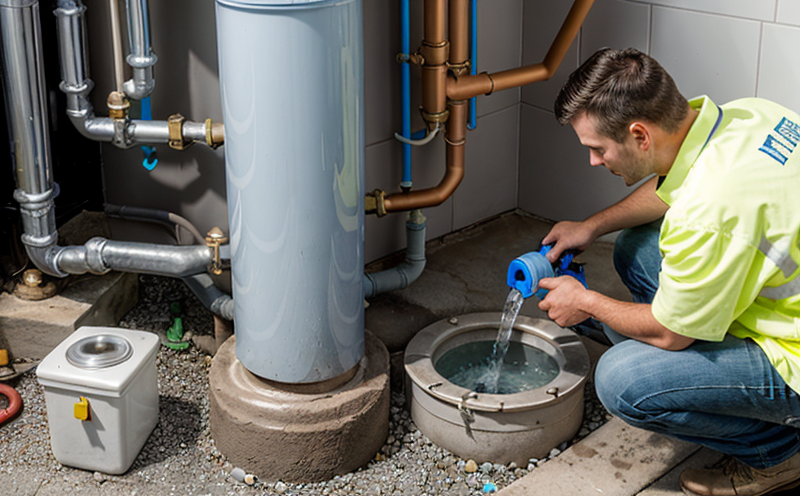ISO 5667-9 Guidance for Water Sampling Plans
The ISO 5667-9 standard provides guidance on the development and implementation of water sampling plans, which are critical for ensuring the quality and safety of drinking water. This standard is particularly relevant in the context of building and infrastructure testing, especially when it comes to plumbing and water systems.
Water sampling plans are essential components of any facility’s compliance strategy, aimed at identifying potential risks associated with water quality issues. These plans help organizations meet regulatory requirements set by local authorities as well as international standards such as ISO 5667-9 itself. By following these guidelines, facilities can maintain confidence in their water systems and protect public health.
ISO 5667-9 emphasizes the importance of proper sampling techniques to ensure accurate representation of the sample being analyzed. It recommends selecting appropriate locations within the plumbing system where samples should be taken based on factors like flow rate, temperature variation, and pressure differentials. The standard also stresses the need for trained personnel who understand both theoretical principles behind water sampling as well as practical considerations necessary when executing such plans.
The guidance provided by ISO 5667-9 extends beyond mere prescription; it encourages continuous improvement through regular review of existing practices. This includes evaluating new technologies or methodologies that could enhance the effectiveness and efficiency of water sampling processes. Additionally, the standard promotes collaboration between stakeholders involved in the design and operation of plumbing systems to ensure alignment with broader objectives related to sustainability and resource management.
For those responsible for managing or overseeing building infrastructure projects involving plumbing works, familiarity with ISO 5667-9 is essential. Understanding its provisions will enable better decision-making regarding water sampling strategies that align with both regulatory expectations and internal quality assurance protocols.
The following sections delve deeper into how this standard applies across various aspects of building & infrastructure testing related to plumbing & water systems, including industry applications, quality assurance measures, practical examples, and frequently asked questions.
Industry Applications
- Drinking Water Authorities - Ensuring compliance with local regulations regarding potable water standards.
- Construction Companies - Integrating water sampling into pre-construction plans to identify potential risks early on.
- Facility Managers - Implementing ongoing monitoring programs using ISO 5667-9 compliant sampling techniques.
The application of ISO 5667-9 goes beyond just compliance; it plays a crucial role in maintaining trust among stakeholders by demonstrating commitment to high standards of water quality management. By adhering to the recommendations outlined in this standard, organizations can build stronger relationships with customers and regulators alike.
Quality and Reliability Assurance
The development of effective water sampling plans is central to ensuring reliable data collection that supports robust decision-making processes within facilities. Properly implemented sampling protocols help minimize errors due to contamination or improper handling, thereby enhancing overall confidence in the integrity of test results.
A key aspect of quality assurance involves adhering strictly to specified procedures for sample collection and preservation. This includes using clean equipment, maintaining proper chain-of-custody documentation, and storing samples under appropriate conditions until analysis can be conducted. Regular calibration checks on analytical instruments further contribute towards achieving consistent accuracy levels across multiple testing events.
Another important element of quality assurance is establishing clear communication channels between different parties involved in the project lifecycle—from designers to operators—to ensure everyone understands their roles and responsibilities regarding water sampling activities. This collaborative approach fosters a culture of continuous improvement where lessons learned from past experiences are continuously incorporated into future practices.
Use Cases and Application Examples
- New Construction Projects: During the initial stages of planning, construction teams often conduct preliminary surveys to assess existing infrastructure conditions. ISO 5667-9 can guide these assessments by specifying optimal locations for water sampling points.
- Ongoing Maintenance Programs: Regular checks conducted according to this standard help detect early signs of deterioration or contamination in plumbing systems, allowing timely interventions before they escalate into major issues.
- Emergency Situations: In case of unexpected spills or leaks, emergency response teams rely on standardized sampling methods prescribed by ISO 5667-9 to quickly ascertain the extent and nature of pollution affecting water supplies.
These use cases highlight just a few ways in which complying with ISO 5667-9 contributes significantly towards achieving desired outcomes in terms of safety, efficiency, and effectiveness within various sectors of building & infrastructure testing. Adopting these practices not only enhances operational performance but also promotes environmental responsibility.





